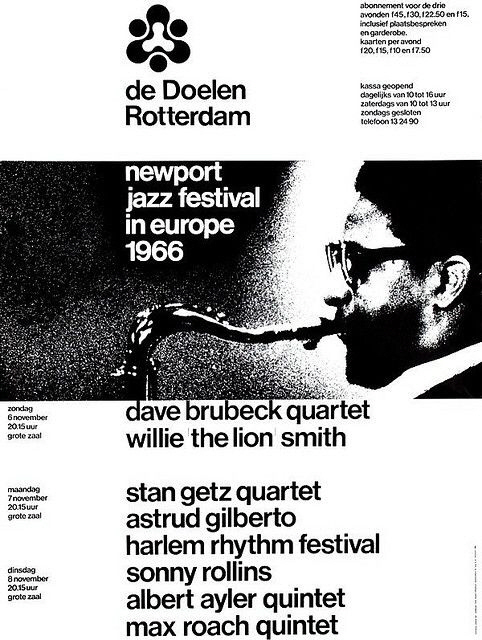|
Music Is The Healing Force Of The Universe The Inconsistency of |
|
|
||||||||||||||||
|
Berlin Jazz Festival, 3 November 1966 De Doelen, Rotterdam, 8 November 1966 Paris Jazz Festival, 13 November 1966 Sigma Festival, Bordeaux, 14 November 1966
Berlin Jazz Festival, 3 November 1966 Die Zeit (18 November, 1966, p. 16) (Download a pdf: Original scan or (better) copy. *
|
 |
||||
|
Utrechts Nieuwsblad (21 October, 1966, p. 6) |
||||
 |
||||
|
Nieuwe Leidsche Courant (9 November, 1966, p. 11) |
||||
 |
|
Utrechts Nieuwsblad (9 November, 1966, p. 5) |
 |
|
Het Vrije Volk (9 November, 1966, p.5) |
||||||||||||||||||||
 |
||||||||||||||||||||
|
De Waarheid (9 November, 1966, p.2) |
||||||||||||||||||||
 |
||||||||||||||||||||
|
Not a review, but here’s a reconstruction of the Ayler section of the programme from the concert: |
||||||||||||||||||||
 |
||||||||||||||||||||
 |
||||||||||||||||||||
 |
||||||||||||||||||||
 |
||||||||||||||||||||
 |
||||||||||||||||||||
|
I’m grateful to Maarten Derksen for sending me a photocopy of the Doelen Festival programme. He also included this note about the concert: “The Albert Ayler Quintet played the Rotterdam concerthall The Doelen November 8 1966. This was part of a three day festival: Newport Jazz Festival in Europe1966. The Max Roach Quintet (with Freddie Hubbard, James Spaulding and others) and Sonny Rollins also played that night. Rollins with Max Roach and Jymie Merritt on bass, did not really do well. Michael Samson was warming up before their appearance playing Bach. Beaver Harris (instead of the announced 'Roundhouse' Shannon Jackson) was having enormous trouble keeping his drums together, because parts fell down or moved away. So a stagehand had to sit next to it. I met Beaver after the concert and we went to the jazzclub B14. There Harris worked down an enormous amount of meatballs.” |
||||||||||||||||||||
 |
||||||||||||||||||||
|
Rotterdam, 08-11-66 On the Amsterdam City Archive site, there are a series of photographs by Nico van der Stam (1925-2000), taken at the De Doelen concerts in Rotterdam in November, 1966. The Ayler group is featured in the following files: *
Paris Jazz Festival, 13 November, 1966 Jazz Magazine (December 1966, p. 19-20)
”Dans le cadre du troisième Paris Jazz Festival et des fêtes commémoratives de la Victoire, la Société Française de Concerts, l’O.R.T.F. et le ministère des Anciens Combattants et Victimes de guerre ont organisé, le dimanche 13 novembre à la salle Pleyel, deux séances récréatives dont le calme et la dignité n’ont aucunement troublé le recueillement qui sied à ces belles journées du Souvenir. La première partie de chaque séance fut consacrée à une émouvante présentation des étendards des régiments dissous, portés par Willie «The Lion» Smith pour ceux de 14-18 et, pour ceux de 39-45, par une unité de combat reconstituée de façon trés vivante avec l’aide de Roy Eldridge, Illinois Jacquet, Milt Buckner, Jimmy Woode et Jo Jones. Interprétée par Max Roach, Freddie Hubbard, James Spaulding, Ron Matthews et Jymie Merritt, une longue marche funèbre ouvrait la deuxième partie, que clôturait allégrement un récital de sonneries réglementaires, donné par la fanfare des tire-Ayler sénégalais.» |
||||||||||||||||||||
 |
||||||||||||||||||||
|
Sigma Festival, Boardeaux, 14 November, 1966 Sud Ouest (15 November, 1966) |
||||||||||||||||||||
 |
||||||||||||||||||||
|
At the French Theater, explosive encounter IT squeals, it yelps, it screams, it squeals, it blows, it bombs: it hums! Albert Ayler's quintet is unleashed: collective madness at its peak. It is, it seems, “free jazz”. We knew the jazz of political protest, here no message: it is only a question of anathema to everything that is concession or musical conditioning, technique included. Ayler and his ilk spit like never before on norms, rules, canons and academicisms. With his self-indulgent Trane vibrato, Ayler's sound is as, if not more, blasphemous as the hoarse bellowing of John Coltrane. Faced with outrageous research in the treatment of sound - equally sensitive to the trumpet (Don Ayler), the violin (Michel Samson), the drums and the bass - the absence of research or, if we want to be lenient , formal, rhythmic and harmonic solutions is all the more disappointing.
Sculpting time... The second part of this evening was devoted to the sculptor Nicholas Schöffer for an experimental audiovisual show. Embryo of total spectacle, assembly of very diverse successive events: light games, ballets, plays, cinema, Nicholas Schöffer's "Carte blanche" had, in fact, to partially obey the laws of chance, some of its components being perfectly indeterminate. This was the case, for example, of the spectator's reactions to the luminous attacks of photographic flashes — a timid but painful outline of a happening! — This was also the case for the choreographic part inspired by Sara Pardo and her contemporary dance company. Audacious confrontation of the mechanical structures of Nicholas Schöffer and a female body which can abdicate all romanticism but not all sensuality. M. C. ICRE.
Next: The 1966 European Tour continued - London School of Economics, 15 November 1966
|
||||||||||||||||||||
|
Home Biography Discography The Music Archives Links What’s New Site Search
|
||||||||||||||||||||
